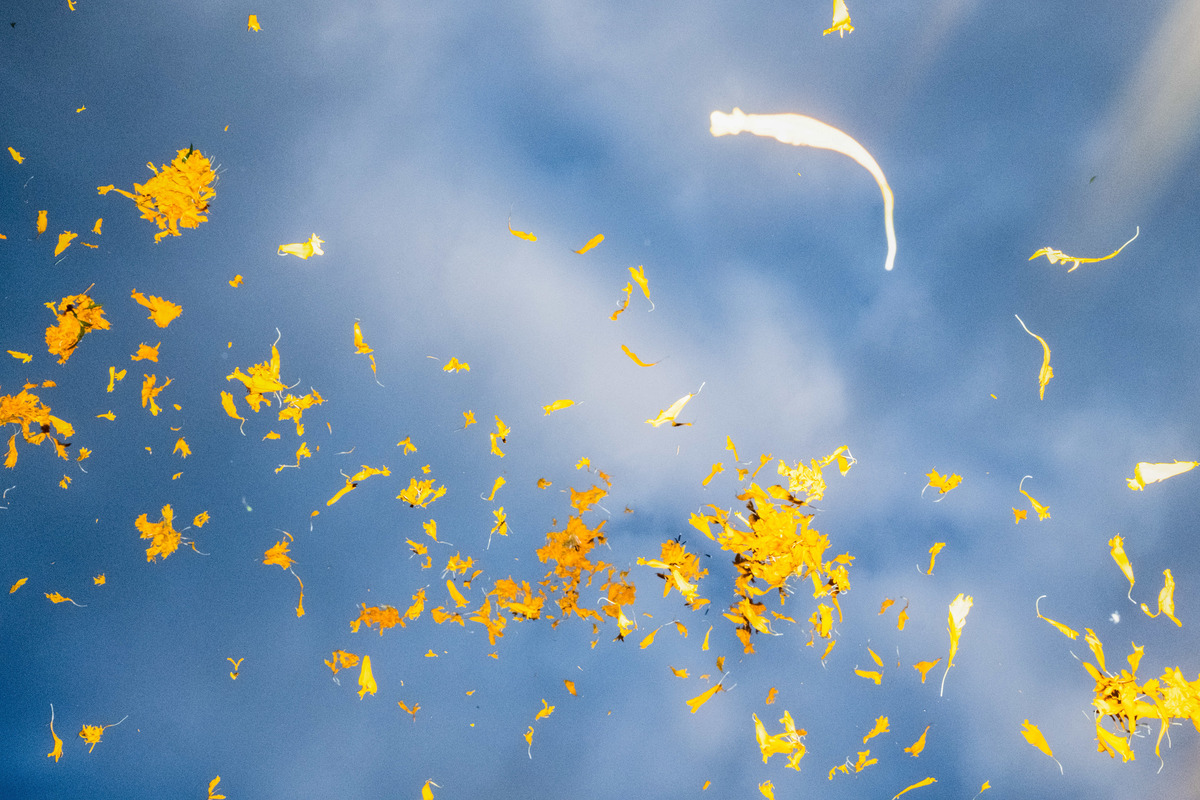Alonso, the son of Maria Fernanda Hérnandez, plucks a cempasúchil flower in San Fúlix Hidalgo, Puebla, Mexico.
Koral Carballo for NPR
hide caption
toggle caption
Koral Carballo for NPR
Alonso, the son of Maria Fernanda Hérnandez, plucks a cempasúchil flower in San Fúlix Hidalgo, Puebla, Mexico.
Koral Carballo for NPR
In the fields of Atlixco, San Fúlix Hidalgo, San Pedro Cholula and San Gregorio Zacapechpan in the central Mexican state of Puebla, golden flowers shine like the sun next to an elegant purple flower. These flowers are the “cempohualxochitl” or “cempoalxóchitl” which in Náhuatl, means “20 flowers” because it appears that inside the flower there are many more. The purple flowers, called “terciopelos,” which translates to “velvet,” are also cultivated in Africa and Asia.
The “Cempoalxóchitl” flowers are known as “Cempasúchil” in Spanish.
Virginia Marin Solis, 68, and Maria Azucena, 26, in San Fúlix Hidalgo, Puebla Mexico.
Koral Carballo for NPR
hide caption
toggle caption
Koral Carballo for NPR
Maria Fernanda Hernandez Reyes y Miriam García Reyes durante la jornada laboral cosechando flor Terciopelo en San Fúlix Hidalgo, Puebla, México.
Koral Carballo for NPR
hide caption
toggle caption
Koral Carballo for NPR
Maria Fernanda Hernandez Reyes y Miriam García Reyes durante la jornada laboral cosechando flor Terciopelo en San Fúlix Hidalgo, Puebla, México.
Koral Carballo for NPR
Maria Azucena Hernandez holds the sickle, work tool, while harvesting Terciopelo flower in San Fulix Hidalgo, Puebla, Mexico. Her hand was held by her son during the workday.
Koral Carballo for NPR
hide caption
toggle caption
Koral Carballo for NPR
For these flowers to adorn Mexican homes, there are thousands of farmers in the country working to plant them, and at the end of October, they begin to harvest, as is the case of Sara and Miriam Ramirez. They come together to harvest at their sister Rosalba’s plot of land. Sara is in her 30s, a single mother with two sons, Pablo and Jesus. Her children accompany her to the fields, where she earns $0.61 for every batch of flowers she harvests. Together, the family works six-hour days, three or four days a year.
Sara and her son Pablo during their work day harvesting Cempasúchil flowers in San Gregorio Zacapechpan, Puebla, Mexico.
Koral Carballo for NPR
hide caption
toggle caption
Koral Carballo for NPR
Sara and her son Pablo during their work day harvesting Cempasúchil flowers in San Gregorio Zacapechpan, Puebla, Mexico.
Koral Carballo for NPR
Cempasúchil flower at sunrise in San Pedro Cholula, Puebla. Abril, daughter of Maria Fernanda Hernandez playing with the petals of the Cempasúchil flower.
Koral Carballo for NPR
hide caption
toggle caption
Koral Carballo for NPR
Abril and Alonso play while their family harvests Cempasúchil flowers in San Fúlix Hidalgo, Puebla, Mexico.
Koral Carballo for NPR
hide caption
toggle caption
Koral Carballo for NPR
Abril and Alonso play while their family harvests Cempasúchil flowers in San Fúlix Hidalgo, Puebla, Mexico.
Koral Carballo for NPR
Harvesting is a tradition in this land. Just like Sara and Miriam, the Marin family of San Fúlix Hidalgo gathers to harvest at dawn. Virginia Marin Solis, 68, says that since she was a child, her mother taught her how to sow, spread the seeds in the field, wait for the rain and, two months later, harvest. Today Virginia shares this once-in-a-year tradition with her children’s partners, Maria Fernanda Hérnandez, Miriam García Reyes and Maria Azucena Violante. The women also bring their children, Abril, Alonso and Roxana, to the fields to pluck the cempasúchil, run through the tereciopelo and play in the fields while their mothers work.
Maria Fernanda Hernandez Reyes, 29, has been harvesting for the last 6 years after marrying Virginia Marin’s son in San Fulix Hidalgo. Miriam García Reyes, 14, has been working for three years in the fields of the Marin Solis family in San Fúlix Hidalgo, Puebla, Mexico.
Koral Carballo for NPR
hide caption
toggle caption
Koral Carballo for NPR
Maria Fernanda Hernandez Reyes, holds a Cempasúchil flower.
Koral Carballo for NPR
hide caption
toggle caption
Koral Carballo for NPR
Maria Fernanda Hernandez Reyes, holds a Cempasúchil flower.
Koral Carballo for NPR
Lula, the Marin Solis family’s dog rests during her family’s workday in San Fúlix Hidalgo, Puebla, Mexico.
Koral Carballo for NPR
hide caption
toggle caption
Koral Carballo for NPR
Lula, the Marin Solis family’s dog rests during her family’s workday in San Fúlix Hidalgo, Puebla, Mexico.
Koral Carballo for NPR
The work of harvesting the flowers is essential at this time of the year so that the women can keep food on their children’s plates year-round. Their work is also important for the flowers to reach the ofrendas — altars where food and drinks are offered up for those in the family who’ve died. Our ancestors in Mexico believed that the cempasúchil had the power to shield the rays of the sun, which served to guide the path of the dead who return from the Mictlán (the underworld, where the dead are) every Nov. 1 and 2 to celebrate with the living: the Day of the Dead.
Maria Fernanda Hernandez’s hair with pistils of the Cempasúchil flower that her daughter Abril placed in her hair in San Fulix Hidalgo, Puebla, Mexico.
Koral Carballo for NPR
hide caption
toggle caption
Koral Carballo for NPR
Abril throws Cempasúchil flower petals to the sky as her parents, aunts and grandparents work harvesting flowers in San Fúlix Hidalgo, Puebla, Mexico.
Koral Carballo for NPR
hide caption
toggle caption
Koral Carballo for NPR
Abril throws Cempasúchil flower petals to the sky as her parents, aunts and grandparents work harvesting flowers in San Fúlix Hidalgo, Puebla, Mexico.
Koral Carballo for NPR


























More News
Netflix’s ‘Baby Reindeer’: A dark, haunting story bungles its depiction of queerness
Harvey Weinstein’s 2020 sex crimes conviction in New York overturned
This collection may be the closest we’ll ever come to a Dickinson autobiography